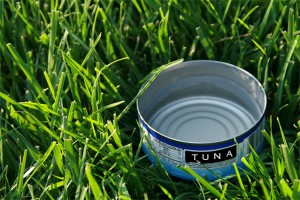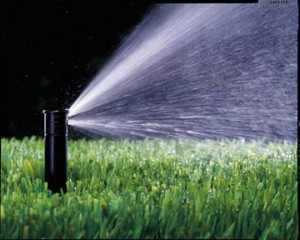Tantalizing. Dictionary meaning: “To tease or disappoint by promising or showing something desirable and then withholding it.”
Are you a teaser? Did you know that you may be tantalizing your lawn with an insufficient amount of water? It is generally recommended by the green industry that turf growing on clay soil receive 1 inch of water per week, and turf growing on sandy soil receive 1.5 inches of water per week as rainfall and/or supplemental irrigation. The Columbia S.C. area receives an average of 1 inch of rainfall weekly March through October. So what is the problem?
There are two problems: (1) Our lawns are not receiving enough water, and (2) We are spoon feeding that water over three to four days during the week. Both of these cultural practices may be causing shallow root systems leading to disorders and diseases in the turf.
Problem #1: Lawns Are Not Getting Enough Water
 A simple irrigation test can reveal if your lawn is receiving enough water. Place five tuna squat cans randomly around the yard, collecting irrigation water from a major water zone. Collect water for 20 minutes; pour contents together into one can, and measure the height of the water in inches. Divide by five. This is the average amount of water your irrigation system is delivering per 20 minutes. Multiply by three, and this gives the amount of water being delivered in one hour. You can divide this amount of water by 60 minutes to determine the amount of water being delivered per minute. Add the total minutes of run times on your irrigation clock. Are you getting enough water after considering weekly rainfall?
A simple irrigation test can reveal if your lawn is receiving enough water. Place five tuna squat cans randomly around the yard, collecting irrigation water from a major water zone. Collect water for 20 minutes; pour contents together into one can, and measure the height of the water in inches. Divide by five. This is the average amount of water your irrigation system is delivering per 20 minutes. Multiply by three, and this gives the amount of water being delivered in one hour. You can divide this amount of water by 60 minutes to determine the amount of water being delivered per minute. Add the total minutes of run times on your irrigation clock. Are you getting enough water after considering weekly rainfall?
Problem #2: Lawns Are Being Intermittently Sprinkled With Water
Insufficient amounts of water will percolate to an insufficient depth of the root system. Most of the root activity will occur in this shallow root zone limiting the turf’s ability to withstand severe drought situations and absorb the needed plant nutrients that reside below the shallow root zone.
The Solution To These Two Problems
Irrigate one time weekly when rainfall fails to supply the necessary water (1 inch in clay and 1.5 inch in sand).
To help you, the reader, further understand the problems and solutions, the following is an excerpt from a yard report for a client last month. The client’s centipede had large patch fungus, caused by intermittent irrigation (more than three or four days per week) throughout the week. These three irrigation intervals during the week caused high humidity on the grass leaves.
Excerpt from Water Management Irrigation Test:
Irrigation rate test revealed that 0.51 inch of water was being applied per week. According to green industry standards, turf should receive one inch of water per week (four inches per month) in clay soil during the growing season. The normal growing season is March through October. The average precipitation (1957 to 2012) for our area is 4.02 inches per month or 1 inch per week. Rainfall as recorded for the past 55 years for your area is as follow:
These are historical averages. Droughts will occur; adjust accordingly.
 Landscape irrigation systems are used as supplemental irrigation. Therefore, landscape irrigation should be used when rainfall fails to provide 1 inch per week for clay soil.
Landscape irrigation systems are used as supplemental irrigation. Therefore, landscape irrigation should be used when rainfall fails to provide 1 inch per week for clay soil.
The diagnostic report indicates that “watering three times a week in this heavy clay soil is excessive and has created ideal conditions for the development of this disease. The homeowner should irrigate weekly when rainfall fails to provide an inch of water.”





